
A Geomagnetic Storm Watch has been issued for Earth for Christmas Eve; a G1-class geomagnetic storm is forecast to impact the planet and NOAA’s Space Weather Prediction Center (SWPC) is warning of possible impacts.
In the latest update from the SWPC, they say the area of impact will primarily be poleward of 60 degrees Geomagnetic Latitude. In this region, induced currents and weak power grid fluctuations can occur on Earth. In space, minor impact on satellite operations are possible. Elsewhere, Mother Nature may have some Christmas lights of her own to share: aurora could be visible at high latitudes across the northern tier of the United States, such as northern Michigan and Maine.
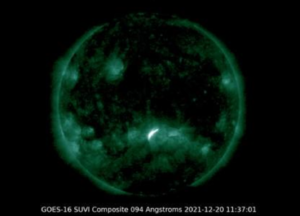
The Geomagnetic Storm Watch is issued due to a solar flare that erupted off the sun just days ago. In a statement released by NOAA’s Space Weather Prediction Center yesterday, they said, “This flare was associated with coronal mass ejection (CME) signatures noted in radio observatory data and GOES-SUVI imagery. The source of this flare was NOAA/SWPC Region 2908. Analysis of this potential CME will continue as more data and coronagraph imagery become available.”
The largest solar flares are known as “X-class flares” based on a classification system that divides solar flares according to their strength. The smallest ones are A-class , followed by B, C, M and X. Similar to the Richter scale for earthquakes, each letter represents a 10-fold increase in energy output. Within each letter class there is a finer scale from 1 to 9.
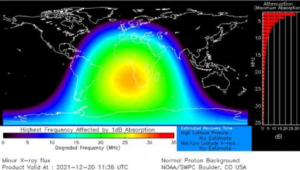
These solar flares could create Solar Radiation Storms on Earth. According to the SWPC, Solar Radiation Storms occur when a large-scale magnetic eruption accelerates charged particles in the solar atmosphere to very high velocities. The most important particles are protons which can get accelerated to large fractions of the speed of light. At these velocities, the protons can rush to Earth in less than an hour after the explosion. When these particles reach Earth, the fast moving protons penetrate the magnetosphere that shields Earth from lower energy charged particles. Once inside the magnetosphere, the particles are guided down the magnetic field lines and penetrate into the atmosphere near the north and south poles.
Solar Radiation Storms can cause several impacts near Earth. When energetic protons collide with satellites or humans in space, they can penetrate deep into the object that they collide with and cause damage to electronic circuits or biological DNA. During the more extreme Solar Radiation Storms, passengers and crew in high flying aircraft at high latitudes may be exposed to radiation risk. During such storms, commercial aircraft can be routed away from areas with the greatest radiation risks. According to the SWPC, when the energetic protons collide with the atmosphere, they ionize the atoms and molecules thus creating free electrons. These electrons create a layer near the bottom of the ionosphere that can absorb High Frequency (HF) radio waves making radio communication difficult or impossible.
NOAA’s SWPC categorizes Solar Radiation Storms using their Space Weather Scale on a scale from S1-S5. A Solar Radiation Storm can persist for time periods ranging from hours to days.

Image: NASA/Mary Pat Hrybyk-Keith
Geomagnetic storms are also rated on a different scale, with a number 1-5 indicating strength and severity. The Geomagnetic Storm expected for Christmas Eve is a G-1 scale event at this time.

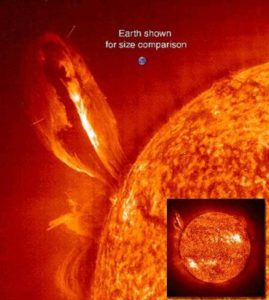
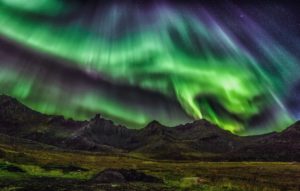
NOAA forecasters analyze a variety of solar data from spacecraft to determine what impacts a geomagnetic storm could produce. If Earth is experiencing the effects of a coronal hole and a coronal mass ejection is forecasted to impact Earth, the combined effects could result in a more significant impact and more intense geomagnetic storming. Analyzing data from the DSCOVER and ACE satellite is one way forecasters can tell when the enhanced solar wind from a coronal hole is about to arrive at Earth. A few things they look for in the data to determine when the enhanced solar wind is arriving at Earth:
• Solar wind speed increases
• Temperature increases
• Particle density decreases
• Interplanetary magnetic field (IMF) strength increases
While these solar events can help illuminate the sky with stunning aurora, they can also do considerable harm to electronics, electrical grids, and satellite and radio communications.
The 1859 incident, which occurred on September 1-2 in 1859, is also known as the “Carrington Event.” This event unfolded as powerful geomagnetic storm struck Earth during Solar Cycle 10. A CME hit the Earth and induced the largest geomagnetic storm on record. The storm was so intense it created extremely bright, vivid aurora throughout the planet: people in California thought the sun rose early, people in the northeastern U.S. could read a newspaper at night from the aurora’s bright light, and people as far south as Hawaii and south-central Mexico could see the aurora in the sky.
The event severely damaged the limited electrical and communication lines that existed at that time; telegraph systems around the world failed, with some telegraph operators reporting they received electric shocks.
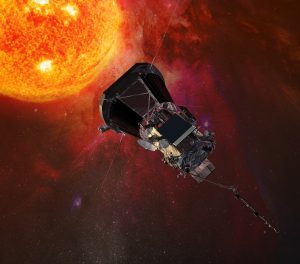
A June 2013 study by Lloyd’s of London and Atmospheric and Environmental Research (AER) in the U.S. showed that if the Carrington event happened in modern times, damages in the U.S. could exceed $2.6 trillion, roughly 15% of the nation’s annual GDP.
While typically known for their weather forecasts, the National Oceanic and Atmospheric Administration (NOAA) and its National Weather Service (NWS) is also responsible for “space weather.” While there are private companies and other agencies that monitor and forecast space weather, the official source for alerts and warnings of the space environment is the Space Weather Prediction Center (SWPC). The SWPC is located in Boulder, Colorado and is a service center of the NWS, which is part of NOAA. The Space Weather Prediction Center is also one of nine National Centers for Environmental Prediction (NCEP) as they monitor current space weather activity 24/7, 365 days a year.